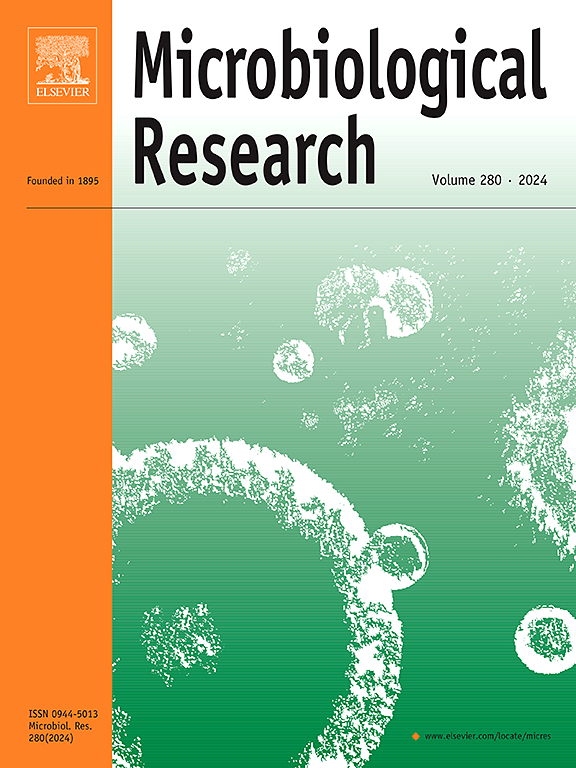Kynureninase from Botrytis cinerea regulates the growth, development, pathogenicity, and stress response of B. cinerea through the kynurenine pathway
IF 6.9
1区 生物学
Q1 MICROBIOLOGY
引用次数: 0
Abstract
The kynurenine pathway was first identified in mammals. It is the main pathway for tryptophan catabolism, participates in many important biological processes, and is a target for the treatment of neurodegenerative diseases. However, this pathway and its function have not been reported in Botrytis cinerea. In this study, the kynurenine pathway-related genes BcIDO, BcKFA, BcHAO, BcKYN, BcKMO, and BcKAT were obtained by bioinformatics analysis. The BcKYNL1 and BcKYNL2 gene mutants positively regulated the growth and pathogenicity of Botrytis cinerea and the stress response. Analysis of the key metabolites of the kynurenine pathway in the mutants △BcKYNL1 and △BcKYNL2 revealed that the significantly changed contents of tryptophan metabolism-related products in the mutants. The exogenous addition of quinolinic acid partially restored the pathogenicity of the mutants. These results indicate that BcKYNL1 and BcKYNL2 regulate pathogenicity by affecting the metabolite content of the kynurenine pathway. In addition, molecular docking and surface ion resonance analyses determined that the kynurenine enzymes BcKYNL1 and BcKYNL2 directly act on kynurenine and 3-hydroxykynurenine of the kynurenine pathway, respectively, and that the branch regulated by BcKYNL2 and BcKMO is the main branch of the kynurenine pathway. These results provide new insights into the mechanism by which the kynurenine pathway regulates the growth and pathogenicity of Botrytis cinerea and the development and application of new targets for the prevention and treatment of B. cinerea.
产自灰葡萄球菌(Botrytis cinerea)的犬尿氨酸酶(Kynureninase)通过犬尿氨酸途径调控灰葡萄球菌的生长发育、致病性和应激反应
犬尿氨酸途径最初是在哺乳动物中发现的。它是色氨酸分解代谢的主要途径,参与许多重要的生物学过程,是治疗神经退行性疾病的靶点。然而,这一途径及其功能尚未在灰葡萄孢中报道。本研究通过生物信息学分析获得犬尿氨酸途径相关基因BcIDO、BcKFA、BcHAO、BcKYN、BcKMO和BcKAT。BcKYNL1和BcKYNL2基因突变体正调控灰葡萄孢的生长、致病性和胁迫反应。对突变体△BcKYNL1和△BcKYNL2中犬尿氨酸途径关键代谢产物的分析发现,突变体中色氨酸代谢相关产物的含量发生了显著变化。外源添加喹啉酸可部分恢复突变体的致病性。这些结果表明,BcKYNL1和BcKYNL2通过影响犬尿氨酸途径的代谢物含量来调节致病性。此外,通过分子对接和表面离子共振分析,确定犬尿氨酸酶BcKYNL1和BcKYNL2分别直接作用于犬尿氨酸途径的犬尿氨酸和3-羟基犬尿氨酸,且由BcKYNL2和BcKMO调控的分支是犬尿氨酸途径的主要分支。这些结果为犬尿氨酸途径调控灰葡萄球菌生长和致病性的机制以及灰葡萄球菌防治新靶点的开发和应用提供了新的思路。
本文章由计算机程序翻译,如有差异,请以英文原文为准。
求助全文
约1分钟内获得全文
求助全文
来源期刊

Microbiological research
生物-微生物学
CiteScore
10.90
自引率
6.00%
发文量
249
审稿时长
29 days
期刊介绍:
Microbiological Research is devoted to publishing reports on prokaryotic and eukaryotic microorganisms such as yeasts, fungi, bacteria, archaea, and protozoa. Research on interactions between pathogenic microorganisms and their environment or hosts are also covered.
 求助内容:
求助内容: 应助结果提醒方式:
应助结果提醒方式:


